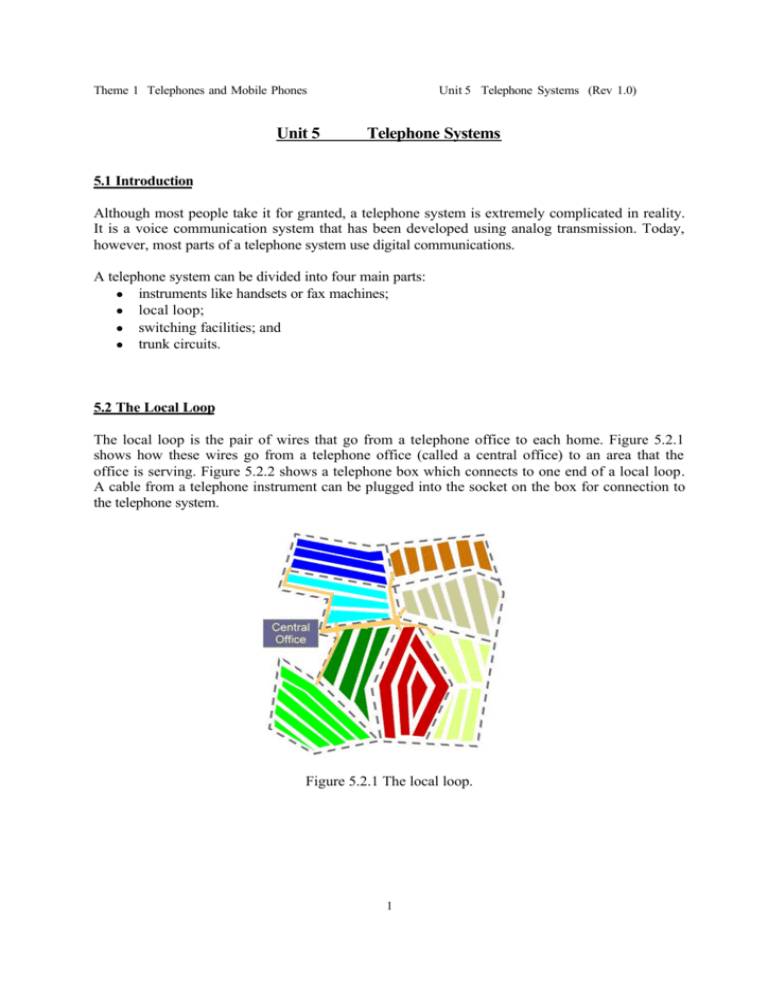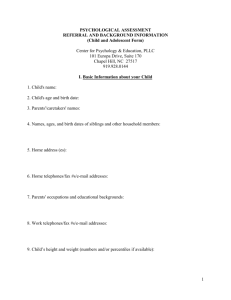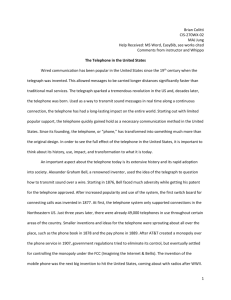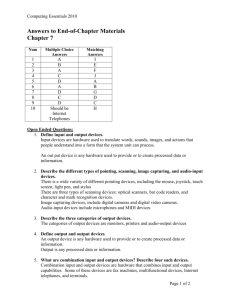Unit 5 Telephone Systems
advertisement

Theme 1 Telephones and Mobile Phones Unit 5 Unit 5 Telephone Systems (Rev 1.0) Telephone Systems 5.1 Introduction Although most people take it for granted, a telephone system is extremely complicated in reality. It is a voice communication system that has been developed using analog transmission. Today, however, most parts of a telephone system use digital communications. A telephone system can be divided into four main parts: • instruments like handsets or fax machines; • local loop; • switching facilities; and • trunk circuits. 5.2 The Local Loop The local loop is the pair of wires that go from a telephone office to each home. Figure 5.2.1 shows how these wires go from a telephone office (called a central office) to an area that the office is serving. Figure 5.2.2 shows a telephone box which connects to one end of a local loop. A cable from a telephone instrument can be plugged into the socket on the box for connection to the telephone system. Figure 5.2.1 The local loop. 1 Theme 1 Telephones and Mobile Phones Unit 5 Telephone Systems (Rev 1.0) Figure 5.2.2 A telephone box. 5.3 Telephone Switching To see why telephone switching is needed, see Figure 5.3.1. If there are only two or three telephones, calls can be made between any two of them if they have direct wires connecting them. In this case, no switching is required. However, if the number of telephones increases, the number of wires connecting the telephones will also need to increase at a very fast pace. Since it is not possible to install so many wires in practice, switching is required. Figure 5.3.1 Switching is required if there are many telephones to be connected together. The concept on switching is simple – setting up and releasing connections between two telephones when needed. However, there are over 600 million telephones in the world. Switching for so many telephones is not an easy task. In a telephone system, switchi ng is carried out by telephone offices. The telephone offices are connected together by trunk circuits in a hierarchical structure as shown in Figure 5.3.2. In the figure, there are two levels of telephone offices. The squares are the higher level ones called toll offices. Each of these telephone offices serves a large geographical area. All the lower level telephone offices in an area, called local central offices (or 2 Theme 1 Telephones and Mobile Phones Unit 5 Telephone Systems (Rev 1.0) simply central offices), will be connected to the toll office of the area via the trunk circuits. With the help of the local loops, telephones are in turn connected to the nearest local central offices. Figure 5.3.2 Hierarchical switching used in telephone systems. 5.4 Advanced Telephone Services Today, telephone systems provide many services other than voice service. These services include Interactive Voice Response (IVR), computer telephony, and others. An IVR system is a system that allows users to input data through the telephone touch-tone keypads. When a user dials an IVR system, he/she actually converses with a computer. By using the keypad on a telephone, the user can instruct the computer to perform operations as desired. Many IVR services are in use today. Examples include banking services, information inquiry and voice mailing services. Figure 5.4.1 An IP phone. 3 Theme 1 Telephones and Mobile Phones Unit 5 Telephone Systems (Rev 1.0) Computer telephony is the new trend in providing voice telephone service. In computer telephony, computers are used for voice communication instead of telephones. The advantage of using computers to replace telephones is that in addition to voice conversations, there are many other types of communications provided, such as video. Since the Internet is widely used today, Internet enabled computers can also be used to provide this kind of service. This is called the Internet Phone service. The telephones that connect to the Internet and provide voice service are often called the IP Phones (see Figure 5.4.1). 5.5 Summary In summary, a telephone system is a system that connects telephones together. Its main function is to provide voice conversation service to the users. To properly perform this function, switching is required. Nowadays telephone systems use a hierarchical switching structure. Although telephone systems were developed using analog transmission, they are almost fully digitized today. Due to the digitization of telephone systems and the advances in computer and communication technologies, telephone systems can now provide many advanced services beside the basic voice communication service. Key Terms Local Loop: The link that connects a home telephone to a telephone office. Telephone Switch: A device that connects multiple telephone lines together and provides communication paths for the lines. Trunk Circuits: The communication circuits between two switching offices. Switching: The setting up and releasing of connections between two telephones when needed. Hierarchical Switching: The switching approach that organizes the switches in a hierarchical (tree-like) structure. Toll Office: A higher level telephone office that usually provides long-distance connections. Central Office: A lower level telephone office that connects to user telephones. IVR: An IVR system is a system that allows users to input data through the telephone touch-tone keypads. IP: Internetworking Protocol, the computer protocol that is widely used in the Internet. Additional Resources Web of fixed network operators OFTA Telephone Country code PPS 4






![Network Technologies [Opens in New Window]](http://s3.studylib.net/store/data/008490270_1-05a3da0fef2a198f06a57f4aa6e2cfe7-300x300.png)

